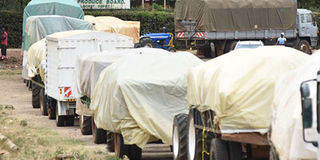Radical reforms to boost maize, agricultural sector

Farmers sell their maize to the National Cereals and Produce Board, Eldoret depot, in Uasin Gishu County on January 21, 2019. PHOTO | FILE | NATION MEDIA GROUP
What you need to know:
- Warehouses and cooperative societies affiliated to NCPB trading division will be required to provide extension and input services to registered farmers.
- The country’s average annual maize deficit is 10 million bags, a gap that is filled with importation, an exercise often marred with corruption.
The government has embarked on reforms to boost the production of maize, the country’s staple food.
Among the changes is the restructuring of the National Cereals Board (NCPB), which has for decades been a sinkhole through which billions of shillings are lost.
NCPB was formed in 1985 to regulate grain stocking and trade. It was also tasked with advising the country on proper production of maize, wheat and other crops.
To complement this role, the Strategic Food Reserve Trust Fund (SFRTF) – established in 2015 – was mandated to stabilise food supply and prices as well as maintain adequate reserves in stock and cash equivalent.
But its stabilising role – in which it buys maize soon after harvest at a price higher than the market rate and selling at below the market price when supplies are depleted – has been blamed for distorting the market and crowding out the private sector.
NCPB staff will be vetted, an exercise that will involve the Department of Criminal Investigation (DCI), according to a government document seen by the Nation.
CONTAMINATED MAIZE
The board will lose at least 25 per cent of its more than 100 stores “to ease effective early participation of the private sector and the establishment of a warehouse receipt system”.
“The National Food Reserve will utilise the warehouse receipt system and voucher incentive programme for market stabilisation through commodity exchange,” the document says.
The system allows farmers to delay the sale of their produce until prices are favourable even as they are facilitated to borrow against receipts issued for goods at designated warehouses.
Under the system modelled on the stock exchange, and already used in Ethiopia, the commodity exchange will facilitate trade of warehouse receipts in a manner that will eliminate the need for physical movement of goods.
“In November 2018, the SFR disposed of 300,000 bags of imported maize bought at Sh3,200, 1.7 million bags bought locally at Sh1,600 and had aflatoxin contaminated maize of 62,285 bags bought at Sh3,200 each that required destruction. The direct loss of this disposal was Sh3.9 billion,” the document says.
Last year, some 1,938,628 bags of SFR stocks were disposed of at Sh2,700 per 90kg sack, with a book loss of Sh1.9 billion.
Agriculture Cabinet Secretary Peter Munya told the National Assembly last week that the thousands of bags of maize in government stores are contaminated with aflatoxin and unsafe for human and animal consumption.
The reforms are also meant to stop the duplication of roles between the NCPB and STRFT, whose leaders have often clashed.
RESTRUCTURE
The changes seek to create a trading division in the board whose role will be to bring together farmers, producer organisations and agro-dealers around aggregation centres for storage, bulk sourcing and marketing, in a manner modelled on Kenya Tea Development Agency’s relationship with factories and buying centres.
Warehouses and cooperative societies affiliated to NCPB trading division will be required to provide extension and input services to registered farmers.
“In return, registered farmers are obligated to warehouses/co-ops by production contracts. The warehouses/co-ops will promote and maintain primary farmer registers, production and stock movement,” the document says.
Last year, President Uhuru Kenyatta formed a task force to review the performance of the maize industry with focus on policy, regulation, declining production, high cost of production, high post-harvest losses, unpredictable and unstructured markets as well as cheap imports.
The report, presented in March 2019, recommended an immediate restructuring of NCPB and the SFRTF to make them efficient and autonomous.
Crop Development Principal Secretary Hamadi Boga said the current system has lent itself to politicisation of maize, which has given it disproportionate attention – drawing focus away from the broader need to improve nutrition and fight hunger.
But the reforms needed to turn around the sector are so comprehensive that tinkering only with NCPB and marketing will not yield the desired result.
BLIGHTED BY GRAFT
Kenya’s maize production is far below global best practice or even regional standards.
The country’s average annual maize deficit is 10 million bags, a gap that is filled with importation, an exercise often marred with corruption.
Another report prepared by the International Maize and Wheat Improvement Centre (CIMMYT) and Kenya Agricultural Research and Livestock Organisation (Kalro) recommends a number of technological interventions, as well as policy and regulatory changes to boost productivity.
They include a designation of maize-growing counties so that investment can be targeted and land in the other regions freed up for other crops.
The document names Trans Nzoia, Uasin Gishu, Elgeyo-Marakwet, Nandi, Nakuru, Narok, Kericho, Kakamega, Bungoma and Kisii counties as the viable maize producers based on a cut-off point of two tonnes per hectare.
“These counties significantly contrast with several others that have vast areas under maize but with very low productivity. For example, Machakos is shown to have an area of 129,000 hectares under maize but with a meagre productivity of 0.5 tonnes per hectare,” the document says.

